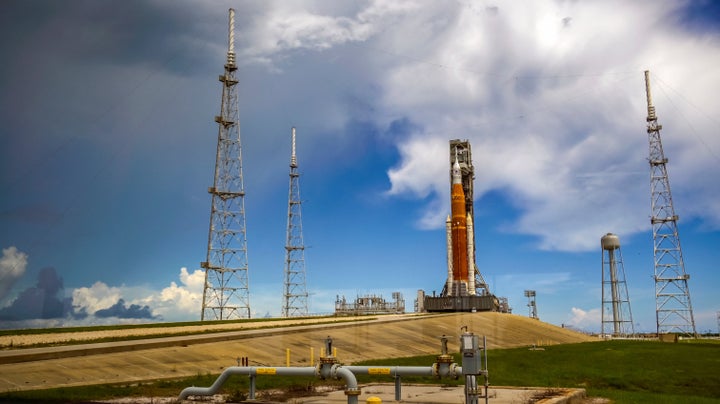NASA rescheduled the launch of its Artemis I mission around the moon to Saturday after the space agency was forced to scrub the first attempt due to an issue with one of the spacecraft’s engines.
The main problem Monday came after engineers couldn’t get one of the rocket’s four engines to the proper temperature needed to start them at liftoff. NASA said the Artemis team tried to quickly fix the issue before the scheduled departure time, but weren’t able to do so before a two-hour launch window closed.
Mike Sarafin, the Artemis mission manager, said the team had found a path forward, including changing the engines’ loading procedure and starting the engine chill down earlier.
The mission is the first in a series of launches that could ultimately see astronauts headed toward the moon for the first time in half a century and a major revitalization of NASA’s space exploration efforts.
The next launch window opens at 2:17 p.m. ET Saturday for two hours, weather permitting. An additional window would open on Monday, NASA said.
If the mission isn’t able to launch, it could potentially be pushed back by more than a month.
The decision Monday was a disappointment for thousands of rocket-watchers who drove to Florida’s Kennedy Space Center, including Vice President Kamala Harris. But NASA said it wouldn’t fire up the rocket until doing so was safe, despite years of delays that have beleaguered the $40 billion project.
Sarafin told reporters Monday engineers would be sifting through data from the first attempt to make sure everything was in order.
“We’re going to play all nine innings here,” Sarafin said during a press briefing on Monday night. “We’re not ready to give up yet.”


“We are going to give the team time to rest, first of all, and then come back fresh tomorrow and reassess what we learned today and then develop a series of options,” he added. “It’s too early to say what the options are.”
Bill Nelson, NASA’s administrator, said the rocket was “brand new,” adding it wouldn’t “fly until it’s ready.”
“I think it’s just illustrative that this is a very complicated machine, a very complicated system, and all those things have to work,” Nelson said during the press conference Monday.
The Artemis mission will test NASA’s Space Launch System, a powerful rocket, that will propel the Orion spacecraft beyond the moon. The mission will be unmanned (holding three humanoid dummies), but the Orion craft will eventually be able to hold astronauts and begin a new era of space exploration. Humans haven’t stepped foot on the moon since the last Apollo mission in 1972, and NASA has pledged future efforts would see the first woman and the first person of color step foot on the lunar surface.
When it does eventually leave, Artemis I will orbit the Earth before being propelled towards the moon. The spacecraft will fly within 60 miles of the moon’s surface as NASA monitors its systems, then go on into deep retrograde orbit for just under a week.
The full mission will last four to six weeks before the Orion spacecraft reenters the Earth’s atmosphere, traveling some 25,000 mph and producing temperatures approaching 5,000 degrees Fahrenheit.
“After about four to six weeks and a total distance traveled exceeding 1.3 million miles, the mission will end with a test of Orion’s capability to return safely to the Earth,” NASA says of the mission.
The Artemis I launch, if it moves forward, will cap an invigorating summer for the country’s space agency. The heralded James Webb Space Telescope has been transmitting magical images from deep space since July, stunning cosmologists and astronomers and ushering in a new era of stargazing.

